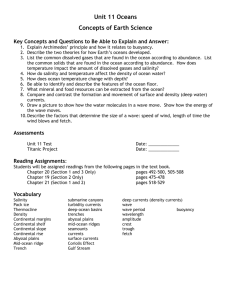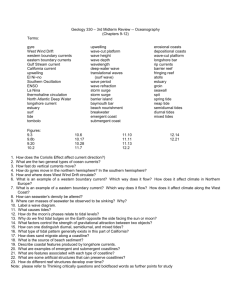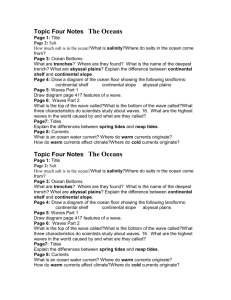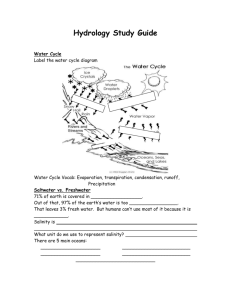Earth Science--Chapter 10 wk 10
advertisement
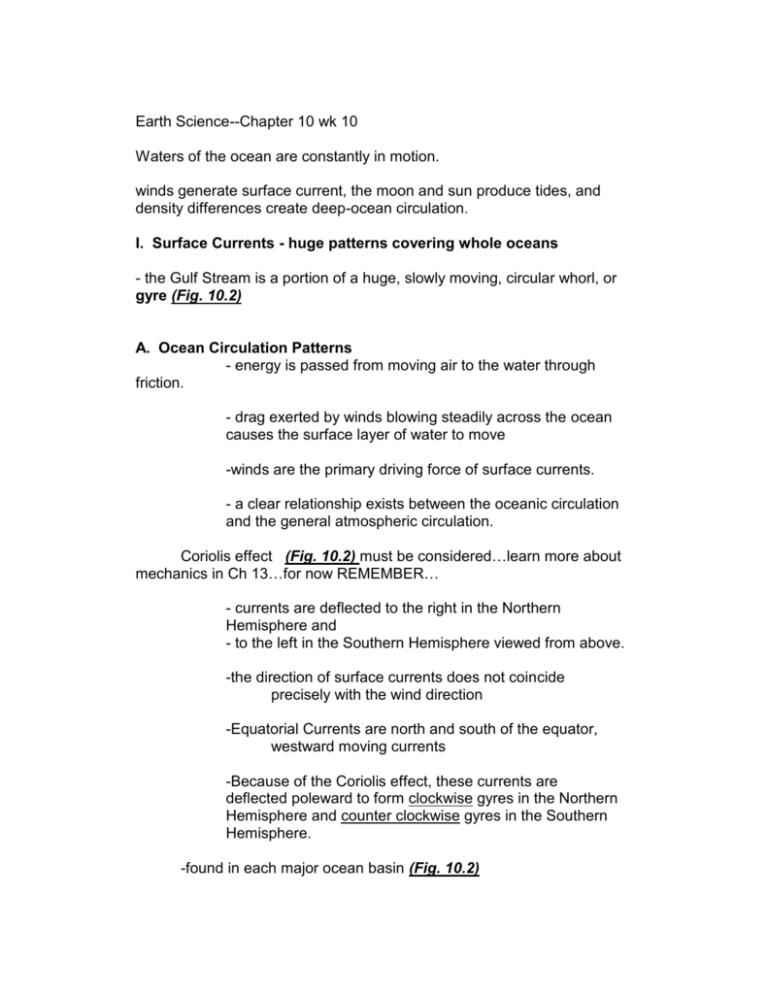
Earth Science--Chapter 10 wk 10 Waters of the ocean are constantly in motion. winds generate surface current, the moon and sun produce tides, and density differences create deep-ocean circulation. I. Surface Currents - huge patterns covering whole oceans - the Gulf Stream is a portion of a huge, slowly moving, circular whorl, or gyre (Fig. 10.2) A. Ocean Circulation Patterns - energy is passed from moving air to the water through friction. - drag exerted by winds blowing steadily across the ocean causes the surface layer of water to move -winds are the primary driving force of surface currents. - a clear relationship exists between the oceanic circulation and the general atmospheric circulation. Coriolis effect (Fig. 10.2) must be considered…learn more about mechanics in Ch 13…for now REMEMBER… - currents are deflected to the right in the Northern Hemisphere and - to the left in the Southern Hemisphere viewed from above. -the direction of surface currents does not coincide precisely with the wind direction -Equatorial Currents are north and south of the equator, westward moving currents -Because of the Coriolis effect, these currents are deflected poleward to form clockwise gyres in the Northern Hemisphere and counter clockwise gyres in the Southern Hemisphere. -found in each major ocean basin (Fig. 10.2) Eth Sci wk 10 p.2 Example – Gulf Stream…. In the North Atlantic, it continues northeastward beyond the Grand Banks, widens, slows until it becomes known as the North Atlantic Drift -As North Atlantic Drift approaches Western Europe, it splits, Canary current moves south this eventually completes the loop, back into North Equatorial Current -Large central area inside the gyre has no well-defined currents (Sargasso Sea) In S. Atlantic, surface circulation is much same as N. Atlantic, just diff names (Brazilian at west, Benguelan on east), and everything circles to left N. and S. Pacific same deal as N. & S. Atlantic -Antarctica, cold surface waters circulate continuously, moving in response to prevailing westerly winds --West Wind Drift B. Ocean Currents and Upwelling -In addition to producing surface currents, winds also cause vertical water movements. - known as Upwelling, the rising of cold water from deeper layers to replace warmer surface water that moves away -most characteristic along the eastern shores of the oceans (Fig. 10.2) -Upwelling occurs in these areas when winds blow toward the equator and parallel to the coast. eath Sci wk 10 p.3 How does upwelling happen?? -the surface water movement is deflected away from the shore. As the surface layer moves away from the coast, it is replaced by water that upwells from below the surface -flow from depths of 50 to 300 meters (165 to 1000 feet) -creates a characteristic zone of lower temperature near the shore. -chilling surprise = dip in Pacific -Coastal upwelling also brings to the ocean surface greater concentrations of dissolved nutrients. Nutrient enriched waters promote the growth of plankton which supports extensive populations of fish C. The Importance of Ocean Currents Fig 10.3 -Important effect on climate -moderating effect of poleward moving warm ocean currents is well known -Great Britain and much of northwestern Europe warmer during the winter than one would expect for their latitudes. -warm ocean currents whose effects are felt most in the middle latitudes in winter, like Gulf Stream heating England the influence of cold currents is most pronounced in the tropics or during summer months in the middle latitudes. Cold currents, such as the Benguela Current moderate the tropical heat. -the aridity along these coasts is intensified because the lower air is chilled . When this occurs the air becomes very stable and resists the upward movement Earth Sci wk 10 p.4 Heat Transfer a key job…. -Ocean currents also play a major role in maintaining Earth’s heat balance. --transferring heat from the tropics to the polar regions -Ocean water movement accounts for about a quarter of this heat transport, winds transport the remaining three quarters. II. Deep-Ocean Circulation -Deep water movements occur as well as surface -deep ocean circulation is governed by gravity and driven by density differences (vs main driver of surf currents…..). -Two factors--temperature and salinity most significant in creating a dense mass of water -Thermohaline circulation (thermo and haline…remember?) -after sinking from the surface of the ocean, waters will not reappear at the surface for an average of 500-2000 years. basic driving mech: water at surface is made colder & more salty and becomes more dense. Denser water then sinks and displaces lighter water light water moves back toward the zone where the denser water formed Dense waters flow away from their source near the poles and are replaced by warmer waters from lower latitudes. Earth Sci wk 10 p.5 -Arctic and Antarctic waters represent the two major regions where dense water masses are created. Temps in Antarctic are cold enough to form sea ice salt is not frozen into the ice, the remaining water becomes saltier. This is the densest water in all the oceans. sinks to bottom of sea floor where it moves through the ocean basins in sluggish currents. III. Tides -Tides are daily changes in the elevation of the ocean surface -Newton applied law of gravitation to them -atmosphere and the ocean both are fluids, deformed by this force -ocean tides result from gravitational attraction exerted upon Earth by the moon A. Causes of TIdes -moons gravitational force can cause the water to bulge on the side of Earth nearest the moon. Fig 10.6 equally large tidal bulge is produced on the side of Earth directly opposite the moon (like stretching a rubber band). -the tidal bulges remain in place while Earth rotates “through” them --Imagine self on seashore for 24 hours …Earth rotates you through alternating areas of deeper and shallower water as you pass through the bulges. Earth Sci wk 10 p.6 -tidal bulges migrate as the moon revolves around Earth every 29 days. Shift about 50 minutes later each day B. Spring and Neap Tides - sun also influences the tides -effect is considerably less than that of the moon -half that of the moon - Spring tides: new and full moons - near these times, sun and moon are aligned and their forces are added together, combined gravity causes higher tidal bulges (high tide) and lower troughs (low tides) largest daily tidal ranges - Neap tides: first and third quarters of the moon, sun and moon act on Earth at right angles, each partially offsets the influence of the other. daily tidal range is less. C. Tidal Currents - Tidal current is term used to describe the horizontal flow of water accompanying the rise and fall of the tide. -Tidal currents that advance into the coastal zone as the tide are called flood currents (a true “tidal wave”) rises Earth Sci wk 10 p.7 As the tide falls seaward moving water generates ebb currents (“ebb tide”….remember the Righteous Bros??). Periods of little or no current, called slack water, separate flood and ebb. Areas affected are called tidal flats. -Tidal currents that accompany a high tide may miles per hour IV. attain a speed of 12 Waves -shoreline is constantly being modified by waves (causing cliffs of poorly consolidated glacial sediment to retreat at nearly 1 meter per year) -Wind-generated waves provide most of the energy that shapes and modfies shorelines -the shore is where a practically irresistible force meets an almost immovable object. A. Characteristics of Waves -waves derive their energy and motion from the wind -if wind exceeds 3 km per hour, more stable waves form progress with the wind (Fig. 10.8) Parts of Waves ---learn them… -Crests- tops of waves -Troughs -Wave height- vertical distance between trough and crest -Wave length-horizontal distance between successive wave crests -wave period - time interval between the passage of successive crests at a stationary point Earth Sci wk 10 p.8 -height, length and period depend to 3 factors: 1-wind speed, 2-length of time the wind has blown, 3-fetch, the distance that the wind has traveled across open water -As the quantity of energy transferred from the wind to the water increases, the height and steepness of the waves increase as well -When the wind stops or changes direction, or the waves leave the storm area where they were created, they continue on without relation to local winds. B. Types of Waves -the motion of the wave is different from the motion of the water particles within it Fig 10.8 -wave form or shape that moves forward, not the water itself -Waves of energy simply move through the nearly stationary medium of the water. -When water is part of the wave create, it moves in the same direction as the advancing wave form -When it is in the trough, the water actually moves backward - these are waves of oscillation - waves in the open sea energy transfer downward as well as lateral… -beneath the surface, the circular motion rapidly depth equal to about one-half the wavelength, the movement of water particles becomes negligible. (Fig. 10.8) KEY POINT earth Sci wk 10 p.9 -When a wave approaches the shore, the water becomes shallower and influences wave behavior. The wave begins to “Feel bottom” at a water depth equal to about one half its wavelength (Fig. 10.10) -As the speed and length of the wave diminish, the energy must go somewhere, the only way to go is up, so the wave steadily grows higher. Finally a critical point is reached when the steep wave front collapses or breaks. - this is wave of translation - in which the water advances up the shore -“surf” - turbulent water created by breaking waves -“swash” - the turbulent sheet of water from collapsing breakers. When it’s energy has been expended the water flows back down the beach toward the surf zone as Backwash V. Wave Erosion - just as streams do most of their work during floods, so do waves perform most of their work during storms. Waves awesome in their violence. Each breaking wave has thousands of tons of water against the land, earth Sci wk 10 p. 10 The pressures exerted by Atlantic Ocean waves are more than 2000 pounds per square foot. Wave impact opens cracks, crevices, etc with lots of force from compressed air forced ahead of wave Fig 10.11 Wave erosion by abrasion too - the sawing and grinding action of the water loaded with rock fragments - especially intense in surf zone VI. Wave Refraction -wave refraction: bending of waves -plays part in shoreline processes, strongly influences where sediment transport and deposition will take place. Regardless of angle of attack, waves try to line up parallel to shore - mechanism …wave slows down in shallow water, wave front refracts toward shore shore Waves refraction focuses energy on headlands, disperses it in bays Fig 10.12 Earth sci wk 10 p. 11 in bay with lowered wave energy, sediment can fall out of suspension and accumulate in the bay….so you see “pocket beaches” between headlands VII Sand movement alongshore Fig 10.13 though refracted, waves still hit shore at angle. 2 components of wave travel - perpendicular to shore - parallel to shore (longshore current) sand grains zig-zag up and down shoreface longshore current moves suspended sediment along the shore - quantities are large: NJ – 750,000 tons/yr Calif – 1,500,000 tons/yr Beach often called “river of sand” VIII Shoreline Features Fig 10.17 Vary from one shore to another - Wave cut cliffs..erosion at base, notch develops, rx fall in Wave cut platform left behind Arches (Fig 10.15) form if 2 sea caves join Stack (one side of arch) left after top part of arch collapses Where sand involved: - Spit: thin sand bar pulled by longshore drift into a bay Example Sandy Hook NJ (Fig 10.16) Baymouth bar: sand bar completely sealing off mouth of a bay Tombolo: sand spit connects mainland to island or island to island (Fig 10.17) - Barrier Islands - espec prominent on Atlantic and Gulf Coasts - usu 15-30 km long (10-20 mi) - lagoons behind them are quiet water, very fine grained seds - Earth Sci wk 10 p.12 B.Islands may form several ways - spits severed from mainland - sand heaped by breakers - former sand dune ridges from last ice age and lower sea leve shoreline evolution generally evolve from irregular to smoother over time…embayments fill while headlands retreat shore from: shore to: waves waves IX. Shoreline Erosion Problems lots of human activity complicates situation….very desirable place to be, but very unstable storms can radically change the beach lots $ spent to attempt erosion control, beach protection Fig 10.18 important factors in how a coast reponds: - proximity to sed input - tectonism - topography, lithology - winds/weather - coastline configuration some artificial ingineering structures: - groins - shore-perpendicular strcs designed to trap sand Fig 10.18 - can have big problem with down-drift erosion because wave activity still hits shore but no sand blanket to absorb energy Earth Sci wk 10 p.13 - seawalls – shore-parallel structure designed to protect property from breaking waves.. loss of beach in front of seawall because wave energy reflected off wall, tends to scour and erode sediment. One strategy increasing employed..beach nourishment Sand placed on beach, often mined from offshore Problem with this sol’n is that it is temporary, because processes that removed original sand to begin with will also remove the nourishment Nourishment not cheap.. Another alternative (#3) is to abandon coastal development by relocating buildings, etc X. Emergent/submergent coastlines Some people classify coastline by either emergent or submergent 1. emergent – land rising relative to sea level for example, California 2. submergent – land subsiding relative to sea level for example, Chesapeake & Delaware Bays- drowned river mouths known as estuaries


